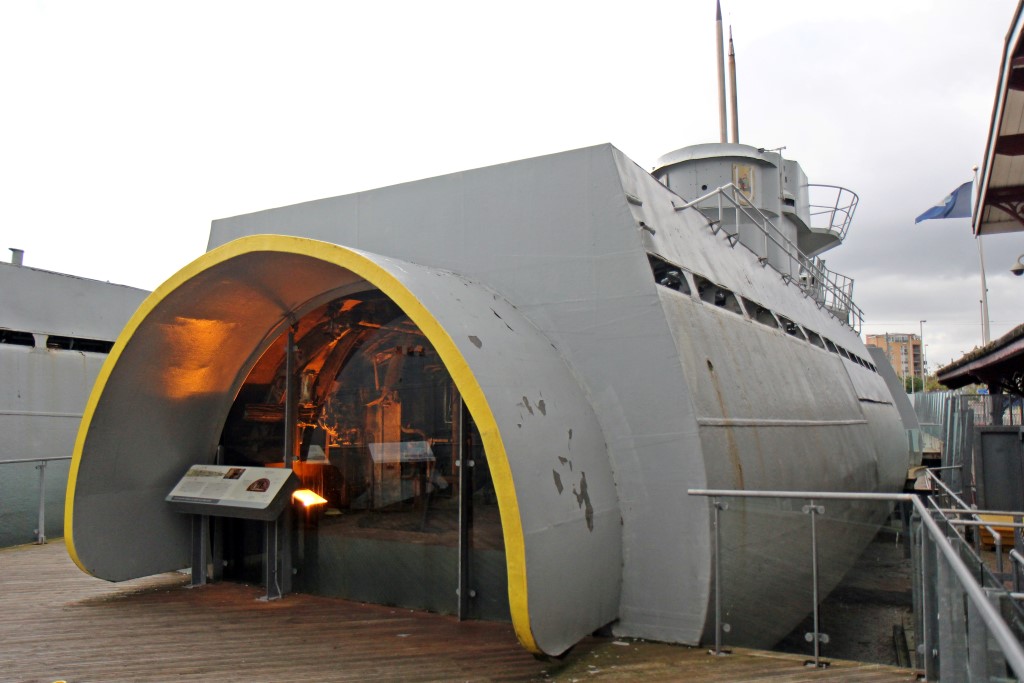U-534 was a Type IXC/40 U-boat of Nazi Germany’s Kriegsmarine during World War II that was sunk in May 1945 by a British aircraft just days before the war’s end.

Remarkably preserved, it was raised from the Danish waters in 1993, offering a rare opportunity for historical and technological examination of its construction and contents.
Today, U-534 is exhibited at the U-boat Story in Birkenhead, England, where it serves as a somber reminder of wartime history and maritime legacy.
Construction Of U-534
The U-boat campaign was a critical element of the Battle of the Atlantic, which aimed to cut off Britain from its supply chains across the globe.
The German Kriegsmarine commissioned a vast array of submarines, and among them was U-534.
U-534 was one of the Type IXC/40 U-boats, a modification of the original Type IX series, reflecting the Kriegsmarine’s continuous quest for improvement.
These were ocean-going submarines, designed not only for endurance but also to operate at great distances from home ports, allowing them to patrol remote seas and to strike Allied shipping routes in the most distant theaters of naval warfare.
The IXC/40 variant boasted an increased range over its predecessors, up to 13,850 nautical miles at 10 knots, due to additional fuel tanks in the aft section.
This made them particularly suitable for the long-haul missions to the South Atlantic, Indian Ocean, and even the waters off Australia and New Zealand.
Constructed at the Deutsche Werft AG, one of Germany’s principal shipyards located in Hamburg, U-534 was built amidst stringent wartime conditions.
The shipyard, well-known for its efficient production lines, was at the forefront of implementing advanced techniques in U-boat construction.
 U-534 at Birkenhead in England.
U-534 at Birkenhead in England.
This facility was frequently targeted by Allied bombings, which added a layer of urgency and difficulty to the manufacturing process. Despite these challenges, U-534 was successfully laid down on 20 September 1941.
It was an era when the Kriegsmarine was still enjoying significant success against Allied shipping, and new boats were eagerly anticipated.
After more than a year of construction, U-534 was launched on 23 September 1942.
This stage was crucial as it transitioned from being a mere structure of steel to a floating entity ready to be fitted out with all the necessary equipment for deployment.
The final phase of U-534’s genesis was its commissioning, a ceremonial act of formally inducting the submarine into active service in the Kriegsmarine.
On 23 December 1942, under the command of Kapitänleutnant Herbert Nollau, it officially became part of the German U-boat fleet.
Kapitänleutnant Nollau was an experienced officer, and under his leadership, U-534’s crew would be trained and the vessel would be prepared for its operational role in the war.
U-534’s Design And Technical Specifications
With an overall length of 76.8 meters, U-534 was slightly longer than the original Type IXCs.
This additional length was primarily due to the expanded fuel storage sections, which were integrated into the aft section of the boat.
The extra fuel capacity directly translated to a longer operational range, which was vital for the long-distance patrols that took these U-boats far into the Atlantic, and in some cases, around the Cape of Good Hope to the Indian Ocean, or around Cape Horn to the Pacific Ocean.
The beam, or the width of the U-boat, measured at 6.86 meters, was a balance between the need for internal space and the hydrodynamic efficiency required for both surface and submerged operations.
The 9.60-meter height included the conning tower, which housed the periscopes, anti-aircraft weaponry, and navigation bridge.
The draught of 4.67 meters determined how deep the boat sat in the water when surfaced.
U-534’s displacement — 1,144 tonnes on the surface and 1,257 tonnes submerged — reflected the boat’s size and the density of the construction materials used.
The hull of U-534 was constructed using high-tensile steel, which could withstand greater depths, theoretically allowing dives of up to 230 meters.
However, operational diving depths were typically much shallower to reduce the risk of damage and ensure a quick emergency surfacing if needed.
 The hull of U-534. Image by Chowells CC BY-SA 3.0
The hull of U-534. Image by Chowells CC BY-SA 3.0
The submarine was powered by two nine-cylinder, four-stroke MAN M9V 40/46 supercharged diesel engines, providing propulsion while surfaced.
These engines were not just powerful; they were also relatively fuel-efficient and reliable, traits necessary for the long voyages undertaken by U-534. When submerged, U-534 ran on two Siemens-Schuckert electric motors.
These electric motors were crucial for stealth operations, as they were significantly quieter than the diesel engines, reducing the chance of detection by enemy sonar.
Speed was an essential factor in both evading enemy attacks and closing in on targets. On the surface, U-534 could reach speeds of up to 18.3 knots, which was fast for a submarine of that era. Submerged, the boat could manage 7.3 knots, a speed at which it could quietly approach convoys or escape from an unfavorable engagement.
Armament-wise, U-534 was fitted with six torpedo tubes; four located at the bow and two at the stern.
This allowed the submarine to engage targets both ahead and behind without needing to turn around, a crucial tactical advantage during wartime engagements.
These tubes were supplied with a total of 22 torpedoes, providing a substantial arsenal for combat operations against Allied shipping.
Additionally, for surface engagements and defense against aircraft, U-534 was equipped with a 105mm deck gun, a standard feature on German U-boats used for attacking unarmed or lightly armed merchant vessels and for self-defense against aircraft when submerged attack was not advisable.
Furthermore, the anti-aircraft armament comprised a 37mm flak gun and a 20mm flak cannon, which provided a necessary defense against increasingly effective Allied air patrols.
Operational History
Launched into service at a time when the Kriegsmarine was beginning to lose its dominance in the Atlantic, U-534’s career was marked by the challenges and dangers that U-boats faced during this period.
After its commissioning under the command of Kapitänleutnant Herbert Nollau, U-534 underwent a period of rigorous training exercises in the Baltic Sea.
This area served as the Kriegsmarine’s primary training ground due to its relative safety from Allied forces and its varied depths and conditions, which were suitable for new crews to hone their skills in navigation, diving, and torpedo firing.
This period was essential for the crew to become proficient in all aspects of U-boat operations, including the use of the complex torpedoes and navigation systems, understanding damage control measures, and practicing the art of stealth and surprise in submarine warfare.
U-534 embarked on its first patrol on 6 June 1943, departing from Kiel, Germany. The U-boat’s operational patrols would take her across the vast expanse of the Atlantic Ocean, where the primary mission was to disrupt and destroy Allied merchant shipping.
Merchant convoys were the lifelines that provided Britain and the Soviet Union with the materials necessary to continue the war effort, and thus, they were prime targets for the Kriegsmarine’s U-boats.
Despite the strategic importance of these missions, U-534’s operational record is notably devoid of any confirmed sinkings of enemy vessels.
This lack of success can be attributed to several factors. First, by the time U-534 was operational, Allied anti-submarine technologies and tactics had evolved considerably.
The implementation of convoy systems, improved radar and sonar technology, and the use of long-range aircraft to patrol for U-boats had made the North Atlantic a deadly hunting ground for submarines.
 An anti-aircraft gun on board U-534. Image by Rept0n1x CC BY-SA 2.0
An anti-aircraft gun on board U-534. Image by Rept0n1x CC BY-SA 2.0
Moreover, the later war years saw the introduction of highly effective anti-submarine weapons such as the Hedgehog and the Squid, which were more precise and deadly than earlier depth charges.
Additionally, Allied codebreakers had made significant advances in decrypting German communications, including the famous Enigma machine cyphers, which allowed the Allies to anticipate U-boat positions and movements.
U-534’s missions also involved reconnaissance and mine-laying operations, which were crucial for gathering intelligence and disrupting Allied naval activities.
The U-boat laid mines around the coast of West Africa and off the port of Freetown in Sierra Leone, which was a major staging area for convoys bound for Europe from Africa and the South Atlantic.
The mine-laying missions were hazardous, requiring the U-boat to approach enemy shores closely, where they were vulnerable to detection and attack.
During her third and final patrol, U-534 sailed around the coast of West Africa to the waters off Trinidad and Barbados, regions that were not typically frequented by U-boats at that stage of the war.
This unusual routing has been the subject of speculation and suggests that U-534 may have been on a special operation, the nature of which remains uncertain.
The Sinking Of U-534
The final chapter in the operational history of U-534 came abruptly on May 5, 1945, just days before the official end of World War II in Europe.
At this juncture, many German U-boats were either surrendering or being scuttled by their crews as part of the Kriegsmarine’s Operation Regenbogen, Hitler’s orders to prevent the capture of the U-boats by the Allies.
However, U-534, under the command of Kapitänleutnant Wilhelm Nollau, chose neither to surrender nor to self-destruct, and its subsequent fate became one of the last combat-related incidents of the Battle of the Atlantic.
On that fateful day, U-534 was cruising in the Kattegat, between Denmark and Sweden, when it was attacked by a British Liberator aircraft from RAF Squadron 547.
The aircraft, equipped with radar and Leigh lights, was conducting an anti-submarine patrol in the area. Leigh lights were powerful searchlights used for night operations, which, combined with radar, made it possible to surprise and attack U-boats on the surface at night.
The attack commenced with the Liberators’ release of depth charges. Depth charges were the primary anti-submarine weapon of the time, designed to detonate at specific depths and create a shockwave capable of crippling or sinking a submarine.
U-534 took a direct hit from one of these charges. The force of the explosion caused severe damage to the U-boat, which began to take on water and lose its ability to remain submerged.
In the ensuing chaos, U-534 managed to shoot down one of the attacking aircraft with its anti-aircraft guns, reflecting the intense and desperate nature of the confrontation. However, the damage to the U-boat was catastrophic.
Nollau ordered the crew to abandon ship as it became apparent that the vessel could not be saved. The U-boat sank beneath the waves shortly afterward, settling on the seafloor of the Kattegat.

U-534 under attack from one of the B-24 Liberator aircraft.
Three of the fifty-two crew members lost their lives in this attack. The rest of the crew managed to abandon the sinking U-boat and were later picked up by the German patrol boats and subsequently became prisoners of war.
The sinking of U-534 was not only significant as one of the last U-boats to be lost in action during the war, but also because it remained relatively intact on the seabed.
The relatively good condition of the wreck allowed for its later rediscovery and salvage, offering a rare opportunity to examine a late-war U-boat in great detail.
The reasons behind U-534’s refusal to surrender when many other U-boats were doing so remain a subject of speculation.
Some historians suggest that U-534 might have been on a special mission, possibly carrying important personnel, documents, or equipment, though this has not been conclusively proven.
The Mystery Of U-534
The circumstances surrounding U-534’s final voyage and subsequent sinking have been a source of intrigue and speculation for historians, maritime archaeologists, and World War II enthusiasts alike.
Its refusal to surrender and the lack of concrete evidence as to why it was targeted and sunk only days before the war’s end contribute to an enduring mystery.
Several theories have been put forward to explain what special purpose, if any, U-534 may have had in those last days of the conflict.
Further enhancing the mystery were the cryptographic materials found aboard the vessel.
While many German submarines were scuttling themselves to prevent their Enigma machines and associated codebooks from falling into Allied hands, U-534’s cryptographic equipment was found intact.
This discovery raised questions about whether the U-boat was trying to preserve these materials for continued use beyond the European theater of war.
The presence of additional fuel tanks on U-534 has also led to conjecture about a possible long-distance mission.
The additional tanks would have extended the U-boat’s range, suggesting it may have been destined for distant shores, potentially to regions far beyond the usual patrol areas of German submarines at that time, such as Japan or the coasts of South America, where several other U-boats are known to have surrendered.
The choice not to scuttle the boat, as was standard practice following the issuance of the Regenbogen order, but instead to attempt to escape and ultimately face sinking by an Allied aircraft, suggests that the crew and their commanders may have considered their mission critical enough to risk a confrontation with enemy forces.
This decision, perhaps more than any item found aboard, has been a key piece of evidence for those who argue that U-534 was engaged in an operation of significant importance.
The Discovery And Recovery
The wreck of U-534 was discovered in 1986 by Danish wreck hunter Aage Jensen. The discovery was made approximately 12 nautical miles off the coast of Anholt Island in the Kattegat Strait.
Utilizing sonar technology, which emits sound pulses and measures their return after bouncing off objects on the sea floor, Jensen and his team were able to identify the unmistakable outline of the submarine lying at a depth of about 67 meters (220 feet).
The use of sonar was crucial, as it allowed the team to conduct a non-invasive search over the large expanse of the sea bed where the U-boat was believed to have sunk.
The initial discovery sparked considerable interest, but it wasn’t until several years later, in 1993, that a salvage operation was mounted.
The recovery of U-534 was financed by the Danish publisher and entrepreneur Karsten Ree, who, intrigued by the vessel’s mysterious past, provided the necessary funds for the salvage operation.
The effort to raise the U-boat was both technically challenging and expensive, requiring specialized equipment and expertise.
The salvage operation was carried out by the Dutch firm Smit Tak. The process began with the divers attaching heavy-duty lifting straps beneath the submarine’s hull.
Given the U-boat’s weight and the delicate condition after decades underwater, great care was taken to prevent further damage during the lift.
The straps were connected to a large floating crane, which painstakingly hoisted the U-boat towards the surface.
It was a slow and meticulous process, necessitating constant monitoring to ensure that the straps held and that the submarine’s integrity was not compromised.
Upon reaching the surface, U-534 was found to be remarkably well-preserved, despite the explosion that had sunk it and the subsequent years underwater.
This condition provided an invaluable snapshot of late-war U-boat construction and offered potential insights into the daily lives of the crew who served on such vessels.
Once recovered, U-534 was transported to the city of Grenaa, where it underwent an initial phase of conservation.
The main goal during this phase was to prevent the rapid deterioration that could occur once the submarine was exposed to the air after years of being protected by the cold, low-oxygen environment of the seabed.
Conservation efforts included desalination treatments to remove salt from the hull, which, if left untreated, could lead to accelerated corrosion.
Later, the U-boat was moved to Birkenhead, England, where it would become a museum exhibit at the Warship Preservation Trust.
Preservation And Exhibition
In its new role as an educational exhibit, the submarine was transported to the Warship Preservation Trust located in Birkenhead, England, across the river from Liverpool.
This location was especially fitting, given Liverpool’s significance during the Battle of the Atlantic as a strategic port and the headquarters of the Western Approaches Command.
U-534 provided a tangible connection to the grim realities of the conflict that had once played out in the very waters that lapped the shores near its exhibition site.
The decision to cut the U-boat into sections was made to provide better access for conservation efforts and to create an engaging experience for visitors.
Each cross-section offered a view into different compartments within the U-boat, revealing the tight quarters, the machinery, and the living conditions faced by the crew.
These open sections allowed conservators to more effectively manage the internal climate and treat specific areas that required attention, thereby prolonging the artifact’s life.
 One of the sections of U-534 on display at Birkenhead. Image by El Pollock CC BY-SA 2.
One of the sections of U-534 on display at Birkenhead. Image by El Pollock CC BY-SA 2.
The exhibition itself was designed to be immersive. By walking through the different sections, visitors could get a sense of the claustrophobic environment in which the submariners worked and lived.
Personal items recovered from the submarine, such as uniforms, personal letters, and other ephemera, were also displayed, giving a human face to the crew members who once inhabited the space.
Moreover, the exhibition aimed to educate the public about the technical aspects of U-boat construction and the strategic role these submarines played during the war.
Interactive displays, information panels, and guided tours offered insights into the operations of U-534, the technological advancements of the time, and the broader historical context of the U-boat fleet.
As a museum piece, U-534 not only memorialized the individuals who served on board but also provided a physical representation of the broader conflict and the technological warfare of the era.
The exhibit became a place of remembrance and reflection, where the legacies of those who served in the Kriegsmarine could be recounted and preserved.
With the closure of the Warship Preservation Trust in 2006 due to financial difficulties, the future of U-534 was uncertain for a time.
However, the historic importance of the vessel warranted continued public display, leading to its acquisition by the Merseyside Maritime Museum.
The U-boat’s sections were transported to Woodside Ferry Terminal, where they became a central feature of the U-boat Story exhibition.
Here, U-534 continues to serve as a poignant reminder of history, offering educational value and a somber remembrance of the past.





